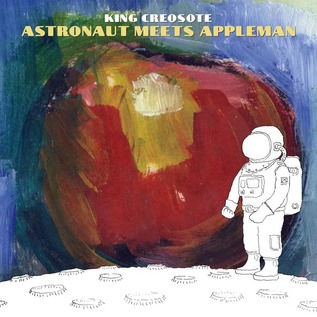It had been a while since we'd managed to get out to see a band. It had certainly been a while since I'd seen King Creosote too - an entire year by my reckoning. It had been a quiet year by Kenny Anderson's standards too - with just two eponymous releases under his belt. However, his return was a triumphant one. While he played the intimate atmosphere of Lantern on his last visit to the Colston Hall, Simply Red were busily creating blandness in the main hall. This time, King Creosote - with his proper tour bus outside - we're playing the main stage. It promised to be an interesting evening...
First up though, were Modern Studies - something of a supergroup, featuring Rob St. John, Pete Harvey of various Scottish bands and Emily Scott along with Joe Smillie of Call to Mind. Thus assembled from individually remarkable pieces of Perthshire, Glasgow, Edinburgh and Lancashire's musical finery, this collectively rather wonderful band have recently produced a debut album - Swell to Great on Song, By Toad. Live, as on the record, Modern Studies take their cues from some of the best quietly powerful acts - I'm hearing a little Low and a little Yo La Tengo. Coupled with Emily and Rob's own explorations of their national folk traditions, and filled out with harmonium, electric piano and cello, this made for a spellbinding set. For once, a Bristol audience was definitely listening to the support band - and the reaction was warm and appreciative rather than the usual cool disdain. The pin-drop quiet in the softer passages was filled with the clanking of harmonium pedals and scraping of bow on cello. This was chamber music for the 21st century, with hints of Scottish ballads and the bleak folk music of the Pennines. It's fair to say that everyone was sad to see them depart, with a collective groan from the audience at the announcement of their last song.
Sometimes, being a King Creosote fan is a bit like being a DIY expert. If you want results, you have to work at it. New songs are best heard by travelling to a remote Fife village and piling into a sweaty room above a rubgy club. Then they'll be reinterpreted on record - likely on a vinyl-only release which is available at shows, or - if the stars align and you're in the right place at the right time - from the resolutely low-tech website of the Alter Ego Trading Company, where things drift in and out of stock regularly, and the whole place shuts down for months at a time. Eventually though, some of the songs make it to one of the more commercially available releases. Kenny's most recent Astronaut Meets Appleman is rare in that most of the tracks here haven't been through this genesis, and have sprung onto record in their fully-formed band version. To do this justice requires quite an ensemble, and tonight he is joined by cellist, organist, synth player and piper among his usual band. All of them arrive on stage in sort of low-fi sci-fi Bowie-esque costume. Stick on stars and hastily cut-out KC lettering, silvery eye make-up and lurid pink and white wigs adorn band members. Amidst this, Kenny appears. And he seems to be remarkably happy!
I'm not suggesting that KC is anything less than entertaining usually, but when he's touring with a band he always seems just a little more chipper. This time, with his entourage in tow and their rather grand bus (apparently great for everything except perhaps the more involved toilet visit!) he's positively beaming. The band are slick and know the material well - working through the whole album in a slightly amended order. The poppier moments - like Love Life sitting neatly alongside the more reflective, drawn out tracks such as You Just Want and the closing The Long Fade. A significant highlight is Melin Wynt where the drone of pipes fills the hall while an insistent bassline drives the song on. As the set draws to a close Kenny notes that encores are silly, and explains that the band will just hide on stage - and they do exactly that, barely concealed behind the various bits of equipment, before heading back to play a request. Each night, they've take a request from the audience, learned it after the show, and played it at the next date on the tour. Thus we get a spectacularly fulsome sounding take on Admiral from 2007's would-be-breakthrough Bombshell album.
Leaving the Colston Hall and reflecting on some of the great (and not so fantastic) acts I've seen here since my teens, I find myself reckoning that this is among the best nights. The company, the music, the atmosphere and the receptive audience all adding up to a pretty special occasion. May there be many more opportunities to see the King at court.
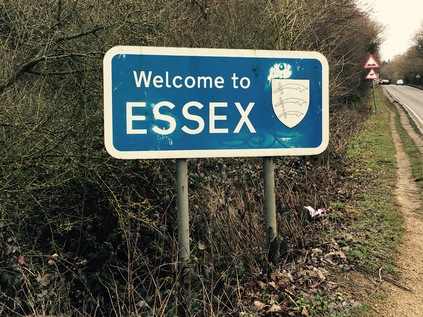
An empty stream, a great silence, an impenetrable forest...
Posted in London on Saturday 14th January 2017 at 11:01pm
Recommencing my explorations in a new year always feels uncertain and unplanned. Heading north to Scotland immediately after the festive season certainly helped me to relax a little, but after a week of catching-up with work and trying to recapture a sense of the normal following a long break, it felt exceptionally good to be putting boots on the ground once again. For a while, the weather had seemed likely to intervene so I hadn't made firm plans, content to watch the forecasts and warnings with a critical eye and with some undercover alternatives in mind. However, the snow shower that swept across the country had largely departed by yesterday and today had dawned dry and frosty. An eerie early mist drifted across Wiltshire as I sped eastwards into the promise of a glorious sunrise, and I finally dared to make some hasty plans for the day ahead. I was a little surprised at my own eagerness to get moving too - I found myself tumbling almost immediately onto a convenient Underground train and skipping my customary coffee at Liverpool Street in favour of finding refreshment along my route. So, much sooner than expected I found myself walking north along Chingford High Street towards a dark line on the northern horizon. While I tramped past the seemingly endless line of tanning salons and estate agents of Chingford I focused on the growing smudge of green in the distance. I was heading out of the city and into the forest...
The edge of Epping Forest was familiar from a previous walk last summer: I remembered how a sea of trees fronted by broad, open space broke against a resolute line of victorian villas, built for their views over this remarkable surviving swathe of ancient woodland - the people's forest as gifted by Queen Victoria. I turned east here, passing a mutton-dressed-as-lamb Tudorbethan hostelry which was in fact an over-gabled Brewer's Fayre and Premier Inn combination. This location on the edge of the forest, in what must have been an earlier twentieth century pub building, was fantastic. However its brassy, false provenance left the genuinely much older Queen Elizabeth's Hunting Lodge looking pale and ghostly beside it. The caricature of history was more photogenic and somehow more three dimensional than the real deal - this squat and haphazard limewashed block which had seen several hundred winters in this exposed spot before it's neighbour appeared and stole the limelight. The inevitable Interpretation Centre nearby was open, but the lodge was locked. A family shuffled out towards the venerable structure with a slightly disgruntled member of staff following to open up the building. They'd clearly hoped for a quiet January Saturday where the punters would be content with coddling themselves in the bar next door, leaving history for warmer opportunities. I crossed the street here to Warren Pond to assess the state of the footpaths through the southern reaches of the forest. A little ice topped the puddled ruts in the track and a remnant of snow lay on a pile of cut branches. I tested a boot on the surface and only slithered a little before the lugs of my soles chewed into a layer of sandy gravel. It felt viable - so my planned excursion could probably work as I'd hastily mapped it out. I turned east again and headed a little further along Ranger's Road. None of the passing vehicles obeyed the speed limit as they hurtled into Essex, a constant trail of taillights winking past me in the ominously dark skies which had settled on the rather bleak vista to the east, displacing the hope of winter sunshine. The road rose and turned a little to the north with the view opening out around me - a few feet ahead a tiny brick parapet was a tell-tale signifier of the presence of water - the inconspicuous River Ching. Beside it a battered and faded blue sign announced simply 'Essex'. I could start walking in earnest now...

The River Ching is a strangely unremarked watercourse which barely registers on the inventory of obscure London tributaries. It doesn't go anywhere of consequence, describes no occult arcs and bubbles fairly unimportantly through boroughs which don't regard it as a feature to be cherished or advertised. It rises to the north of the bridge on which I first caught sight of it, just beyond Connaught Water, and joins the Cuckoo Brook before passing below the bridge on which I stood and heading south into a wooded valley which skirts the high ground of Chingford. Here at Ranger's Road, the rather lively, narrow stream linked the great expanse of woodland to the north with the tail of the forest which still curls southwards and encroaches on the city. I crossed the street and passed a vehicle barrier before disappearing among the ancient trees of Essex. Initially there was a well made track with a screed of sand and stone underfoot, but as the path edged around the fence of a large property, the trail became a muddy bridleway. I passed a pair of horses being ridden back towards the road, their haughty riders not returning my acknowledgement, and then I was rather suddenly alone. The ground in the forest was thick with golden oak leaves, some slowly mulching into the sodden, black earth. This wasn't a result of the melting ice or a recent downpour - this woodland floor had absorbed the rainfall over long, wet centuries. It was probably never fully dry. The aroma of decaying wood surrounded me and twists of holly and ivy curled from around the bare trunks of the oaks. Slowly, as I pressed onwards, carefully keeping my feet out of the worst of the mud, the sounds of the suburbs receded completely. Rather suddenly I burst into a wide open space where the cloud cover had broken enough to let shafts of sunlight reach the frost, clearing it in broad patches. Whitehall Plain appeared to be a pleasantly grassy field, but on closer inspection was in fact a marshy trudge. The earth sucked at my boots as I tried to walk the edges of the path, using the deep tufts of grass for extra traction. It was hard to resist breaking the ice on the horseshoe prints, but I was already conscious that my boots and trousers had a thick covering of pale, Essex earth and couldn't risk an ankle-deep mud puddle. I made for the southwestern corner of the field, where a gap in the trees indicated the makeshift trail continuing south. The map was only partially useful here - this trail didn't officially exist, and I confess to some anxiety that I'd come a long way on fairly tricky terrain. Retracing my steps didn't feel like an edifying option at this point. At the corner of the field I was faced with a choice - and with a close encounter with The Ching which babbled invitingly close to the path. A small bridge crossed it here, but it was beyond a huge slimy pool of mud. I wasn't really sure that this was the correct way ahead - but the lure of the water was strong. I edged closer, finding the undisturbed ground at the river's edge more walkable. Suddenly, and rather surprisingly, I found my toes dipping into the watercourse. As the mud from my boots clouded the little stream and washed them clean, it occurred to me that this was the first time on my many riparian walks that I'd physically made contact with a river which I was walking. It was an odd experience, but satisfying too to see the patch of muddy water billowing away from me. My shoes didn't stay clean for long - after the bridge, the path disappeared into the undergrowth in a way which suggested it was far less substantial than the one I'd left before crossing the river. This couldn't be the best option - so I edged back over and through the tricky swamp to regain the path I'd left at Whitehall Plain. I was soon in a second wide field and making much better progress, occasionally the sun flickered through the trees and my footing felt steadier. A jogger appeared, huffing along the path towards me. I could feel civilisation returning.
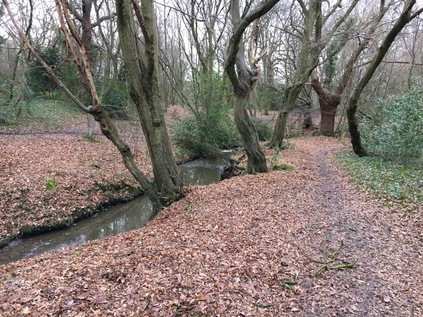
My brush with the suburbs didn't last long - I crossed Whitehall Road close to the point where the Ching passed beneath a decorative but otherwise inconspicuous concrete parapet. At the other side of the street there were paths on both sides of the river - but the western path, running close to the back gardens of a crescent of houses, was just a little less muddy and overgrown in appearance. I was soon trudging along close to the meandering river once again as it ambled between the trees. It was cool and quiet beneath the canopy of branches, and now that I'd found my feet a little I felt able to wander confidently along the trail. Occasionally I'd dare to stray a little off the path to the bank of the river as it curled between the venerable trunks of the forest. The water was clear and free of litter here - and I found myself wondering how it would look further along it's route. As I shuffled through fallen leaves back towards the path I spotted a sleek, red fox standing watching me ahead. I slowed my pace and locked eyes with the remarkable animal, which didn't budge at all. It stood calmly regarding me with interest and perhaps some suspicion as I crunched along the stony track which had replaced the mud. Eventually, with only a few feet between us, the fox flattened itself to the ground and launched swiftly into the ferny undergrowth. I halted and stayed quiet in the hope of perhaps catching another glimpse - but all was silent. I checked my map - this track formed the access to a nearby house, and even had a name - Newgate Street. Suddenly, and unexpectedly, I found myself at a busy roundabout with the Ching passing underneath. A miserable drizzle was falling, and the cars were kicking up a dirty spray as they shuddered by. I spied a range of shops leading towards Chingford Hatch and headed that way to get a drink. As it happened, a small filling station with a general store was the nearest option and I slipped inside to avoid straying too far from my plan. As the door opened I was immediately hit by the acrid reek of over-cooking cheese - the powerful fumes from the Subway concession almost drove me out before I could grab a bottle of water, and certainly put paid to any hunger which might have been rising. As I tried to hold my breath through the achingly slow transaction, the sales assistant appeared utterly unconcerned by what I was now convinced was some sort of emergency in the back of the garage. I was glad to be back outdoors in the clear air of the cold, grey morning again.
To continue walking the Ching I had to leave it briefly, taking the southeastern fork of the roundabout and heading back into the forest. As I set off, I spotted the path I could have taken on the eastern bank of the river trailing in from Woodford Golf Club. The road began to climb a little, passing pleasant streets and delving back into a thick knot of trees. Soon I found the trail leading south, and after a brief slither down a bank between the trees in sight of a dog walker who politely pretended not to see my unsteady progress, I closed in on the river again, now running to the west at the foot of a steep bank. The path rose, leaving the river again and soon came up against the fence of Higham's Park. This particularly treacherous stretch of mud was hard going, and the temptation to flit into the more manicured environs of the park via one of the stiles which separated it from the forest was strong indeed. I persisted, and was soon rewarded with a wonderful view of a lake emerging from between the trees. The rain had stopped and the waters were still, broken only by the wakes of stately swans gliding across towards the furthest bank. I rested awhile, rather taken with the quiet spot nestled between the comparatively bustling suburbs of Woodford and Chingford Hatch. It was soon time to press on - and to leave the forest completely. At The Charter Road, near another neat concrete bridge, I left the river and plunged into a built-up avenue. At the end of the street, a footpath beside Highams Park School reunited me with the Ching in a scrubby triangle of waste ground where the various developments had left a void between their boundaries. A substantial part was given over to allotments, but this narrow and hemmed-in corner was useless and unloved. The river had changed - litter tangled around the railings, and the banks were strewn with discarded household items. It seemed barely possible that this was the same babbling stream which had first appeared in open country and which had accompanied me through the silence of Epping Forest. It was time to confront the urban face of the River Ching...
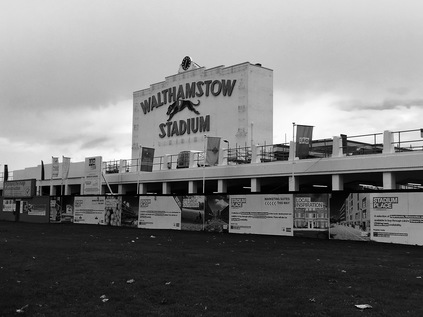
Many of the rivers I've walked disappear entirely at this point, submerged into culverts which sneak under the city, leaving me seeking telltale signs of their presence beneath. But the Ching remains almost entirely above ground, even when it cuts across the lower reaches of Chingford towards the Lea Valley. That's not to say the river is always accessible, and I realised that my route here was at best speculative. The Ching flows between the back gardens of long terraced avenues, and marks the boundaries of inaccessible school fields for much of this part of its course. But first I had to pass under the railway, with the river in a narrow channel beside me as I turned into the accurately named River Walk. The yellow brick viaduct arched over both the path and the Ching - but the Network Rail information panel identified the watercourse only as 'Stream'. At the end of River Walk, an end-of-terrace house was decorated with a mural depicting a white owl in flight, and urging me to respect nature. Here the river once again disappeared between streets of pleasant victorian terraced houses, and I had to detour around these to get to yet another school where a shared cycle and footpath joined the waterway again for a brief stretch. On the other side of my path tall blocks of modern homes were being built - the first of them already occupied, bored children staring down at the footpath - on the site of Walthamstow Stadium. The map showed the distinctive oval of the dog track preserved in the footprint of the new homes, it's iconic fascia memorialised to front the development. The white wall with its distinctive lettering looked like a bright and stark headstone against the grey glass behind it. It was the spectre of a place - a lost memory that meant little to the families which now lived behind it in Parade Gardens. The river disappeared briefly underground here to pass under Chingford Road - a busy tide of traffic prioritised over a few of us hapless pedestrians navigating a complex of crossings. When I finally arrived at the other side of the road, the river re-emerged, sluggish and clotted with junk, beside the access road to a vast Sainsbury's Superstore. The temple of retail was so huge that a Holiday Inn had been enveloped by its car park - or perhaps shoppers needed to break their visit and rest overnight after trudging the endless aisles? I braved the store, needing food and facilities. It felt a little odd to be surrounded by impatient, jostling humanity after my solitary forest walk.
Emerging from Sainsbury's refreshed, I noted that the early promise of sunshine was finally being delivered. The wet car park shone back at me, and I tried to appear as unassuming as possible as I slunk off to the edge of the site near the delivery bays where vast juggernauts of produce were disgorging into the store even now. On the map at least, a footpath appeared to edge around the site, shadowing the Ching as it wound around the regenerated footprint of the infamous Chingford Hall estate. I found the path, and followed it until it finally petered out at the edge of a further huge supermarket. While the bank of the river looked walkable for some distance ahead it was fenced off and marked as private land, with dire warnings for trespassers. I negotiated the edge of the supermarket car park and took a footpath leading into the quiet streets of the estate. Chingford Hall was one of the large-scale housing developments which promised so much in the 1960s, but became synonymous with urban decay and fear in later decades. Its towers were felled, one by one, and by the early part of the 21st century it had risen again in its new form - low-rise blocks in defensible cul-de-sacs, utility blocks with local shops and pubs, public space and playgrounds. But despite following the 'Secured by Design' playbook, Chingford Hall is still troubled by tensions between gangs, poverty and isolation. The local pub was derelict and open to the elements and the chip shop owner was nervously eyeing a gaggle of youngsters staging a half-hearted food-fight across a table. The quiet Saturday afternoon was palpably tense in a way I rarely sense in inner London nowadays. The roads mocked the river's hidden passage: Burnside Avenue, Ching Way. My escape from the estate was to be via more familiar territory - and since I'd left the supermarket I'd been able to detect the drone of the ubiquitous North Circular. At the end of Ching Way, a curved brick entrance opened onto the A406 near the point I'd crossed it months ago. On the estate-facing side of the wall an ancient VCR had been hurled at the ground, splaying it's archaic electronics across the path. I stepped over it and into the maelstrom of fumes and noise beyond. It was like stepping into a wholly different world. And perhaps this mad screed of traffic marking its border is why Chingford Hall feels so inescapable? The road marks a division between territories. Crossing the footbridge seems ill-advised, and the boundary must be defended. Despite standing above six lanes of pulsing hydrocarbon fumes, I felt able to breathe without the tight knot of tension which I'd experienced in the estate.
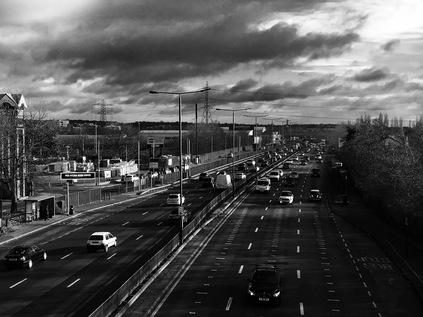
Descending from the footbridge, I felt oddly at ease. I was in familiar territory. The vast white slab of Costco rose above the trees, and signs at the litter strewn junction of Folly Lane and Harbet Road promised more industrial estates nearby. The land here is flat and open - part of the wide plain at the bottom of the Lea Valley which is filled with a tangle of watercourses and crossed by only infrequent arterial routes. As the North Circular bucked and swerved north towards Edmonton and my recent encounters with other tributaries, I turned west. The Ching was canalised here, running in a deep concrete channel with powerlines strung overhead. The lowering sun glinted from the water, and the clouds rolled dramatically over the valley. The conditions were perfect for this liminal zone, and I found a new eagerness to walk. There was only a little more of the tiny but persistent river left as it delved, arrow-straight towards the Lea. The road weaved around a pumping station complete with attractive workers' cottages, before crossing an aqueduct carrying a man-made drainage channel parallel with the Lea. Then suddenly, I found myself above the Lea, looking at the opening of the Ching's culvert. After passing under the aqueduct the river ended inauspiciously, joining the Lea as it curled around the banks of Banbury Reservoir. The sun was low over the water, and the march of pylons was a line of brooding shadow-walkers. I paused and tried to connect the tiny brook in the forest with this green, oily ending. It had been a brief journey in terms of distance - but it occurred to me I'd probably been able to stay closer to the route of the little River Ching than I had when walking other streams. I navigated the tongue of land which housed a rapidly disappearing industrial estate. I'd walked here only a few months ago and all had seemed intact, but now buildings were hollow shells with last year's calendars flapping on their exposed interior walls. I learned later that this woudl be part of Meridian Water - a new suburb rising from the dust of Edmonton, mercifully upwind of the Waste Incinerator - at least most of the time. This eastern part of the site will be reserved for employment, and linked to new housing by means of The Causeway - presumably an upgrade of the deeply pedestrian-unfriendly bridge carrying the A406 towards Angel Road station and the west. Looking back, I didn't consider these vistas threatened or this land desirable - but now the bright frontage of the tiny, closed greasy spoon caff on Towpath Road seemed oddly poignant. As I walked south the wind carried the weird, disembodied cheers and songs from White Hart Lane over the valley, away from the bright halogen of the floodlights.
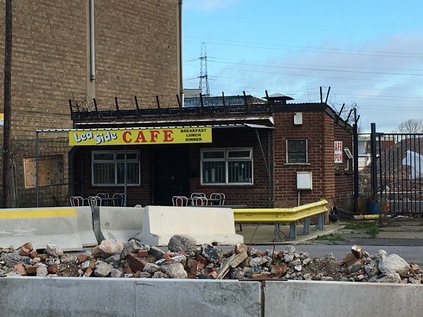
At Stonebridge Lock I rested outside the fine little café which seemed a world away from it's near neighbour just along the river. While the informal and friendly owners shambled around preparing drinks and snacks for the surprisingly steady flow of visitors, cyclists relaxed in the sun and thirsty dogs ambled around their owner's feet. I bought a coffee and sat outside, resting my legs and contemplating pushing on further than Tottenham. I felt better than I had for a long while, and I thought I could manage it. But I also wanted to rest and mull over the strange contrasts I'd experienced today. The bright winter light was lowering to the south west, and the Lea Navigation was a reflective river of black water. The edges of London are constantly torn and remade but somehow its waterways persist - in the margins of developments, delineating parcels of land, and rising in protest at being curtailed or culverted. Choosing to walk these ancient routes has linked the disjointed fringes of the city in a way I'd never have expected. I sipped my coffee and contemplated my next move.
You can see a gallery of images from the walk here.
Almost exactly a year ago, I wrote my goodbye letter to Glasgow here. It had been a difficult day where my hitherto reliably steadfast dependence on the places I knew best had let me down. I'd found the city which had usually given me a rare sense of home, wanting. Over the past year I've thought a lot about that day - not least because it worked as a microcosm of the bigger changes my life has passed through these past few years: realising that things were changing outside my control, at a pace I couldn't dictate. I've had to learn to understand that - and I'm still working on coming to terms with it in some ways. So when I found myself suggesting that we spent a night in Glasgow on our approaching new year tour of the north, I was a little surprised. The idea of spending a night - waking up early and pacing the city, watching passers by from familiar coffee shop windows - was oddly comforting. Perhaps it was worth another try - and it would at least be just one night...
As we navigated the convoluted off-ramps of the urban M8 down to street level, I watched the cliff-face of tall buildings which cluster around the north bank of the Clyde at Anderston with growing excitement. Arriving in Glasgow this way - by road from the south - was a new experience, with all the exhilaration of soaring motorways cutting through the incomplete regeneration schemes while the sun reflects from red sandstone tenements stacked up the hills of the city. Arriving at our hotel for the evening was equally interesting - I'd stayed here a decade back when it was the decaying Quality Hotel Glasgow Central - a once proud railway hotel falling into disrepair as its owning company slowly went out of business. However, restored to it's former grandeur as the Grand Central Hotel it's now a comfortable and luxurious stop-over in the city centre. We don't stray far for the evening, enjoying the same restaurant that saved the day a year ago.
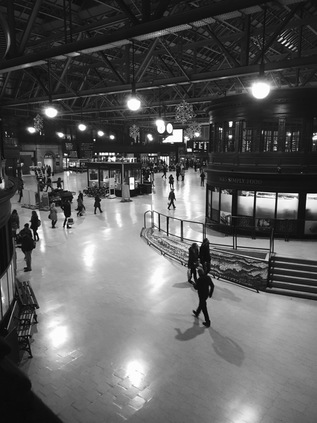
This morning I set out early, onto the slick pavements which I'd so often pounded early. I retraced an old route around the city centre, to Queen Street station for a glance at the trains. In the midst of refurbishment and electrification it was quiet and a bit battered looking, but the thrill of trains to far-flung points at the end of the network was still present. As I headed for a familiar coffee stop and used the quiet morning to write and catch up on correspondence, I watched the city waking outside - the darkness turning into the silver-grey of a typical Glasgow morning. The stores began to open, and the commuters hustled along Buchanan Street to work. I recalled the feeling of being relaxed and content I used to get here when I'd escaped for a visit, and realised I felt pretty similar. Perhaps Glasgow hadn't changed so much - or perhaps more surprisingly I hadn't either?
Later we headed west to the Botanic Gardens. There was a little weak sunshine above, and the park was surprisingly busy for a chilly January afternoon. On our way to exit, we stopped to look at the remains of Botanic Gardens station, green and damp beneath the earth of the park. I'd visited these before, in very different times - and like Glasgow itself, they remained solid and weatherbeaten - but, they remained. Getting back here and staying for a night had given me a chance to recalibrate to the rhythm of this unique city, and getting out into the dark morning had allowed to feel part of its story again. We both admitted that, despite the next leg of our trip being ahead, we didn't want to leave. What a difference a year makes...
Lost::MikeGTN
I've had a home on the web for more years than I care to remember, and a few kind souls persuade me it's worth persisting with keeping it updated. This current incarnation of the site is centred around the blog posts which began back in 1999 as 'the daylog' and continued through my travels and tribulations during the following years.
I don't get out and about nearly as much these days, but I do try to record significant events and trips for posterity. You may also have arrived here by following the trail to my former music blog Songs Heard On Fast Trains. That content is preserved here too.
